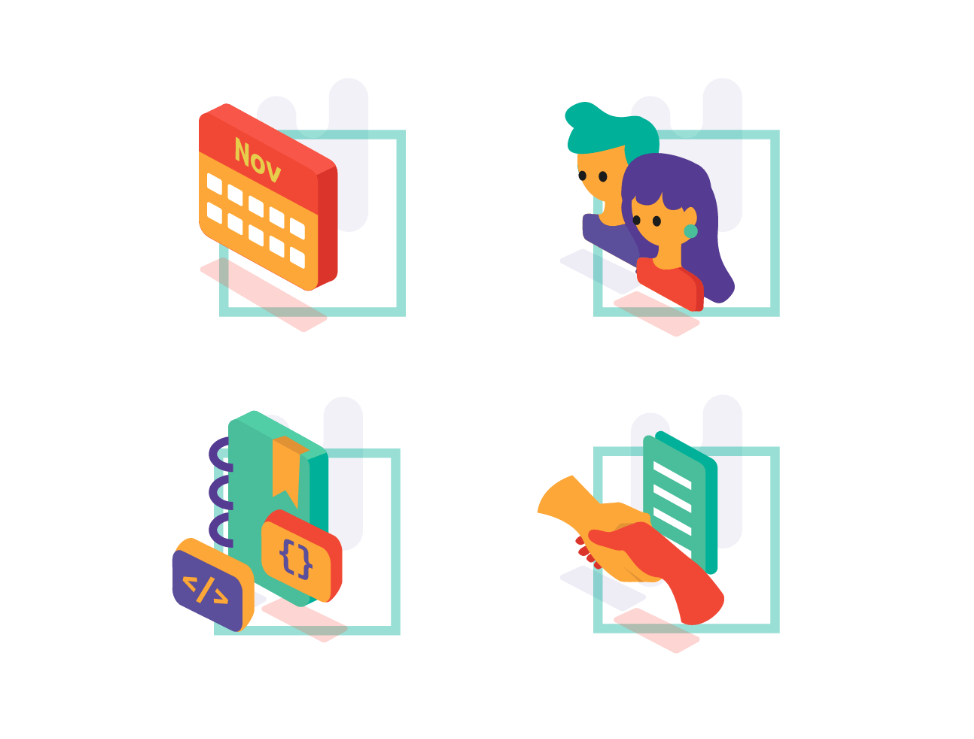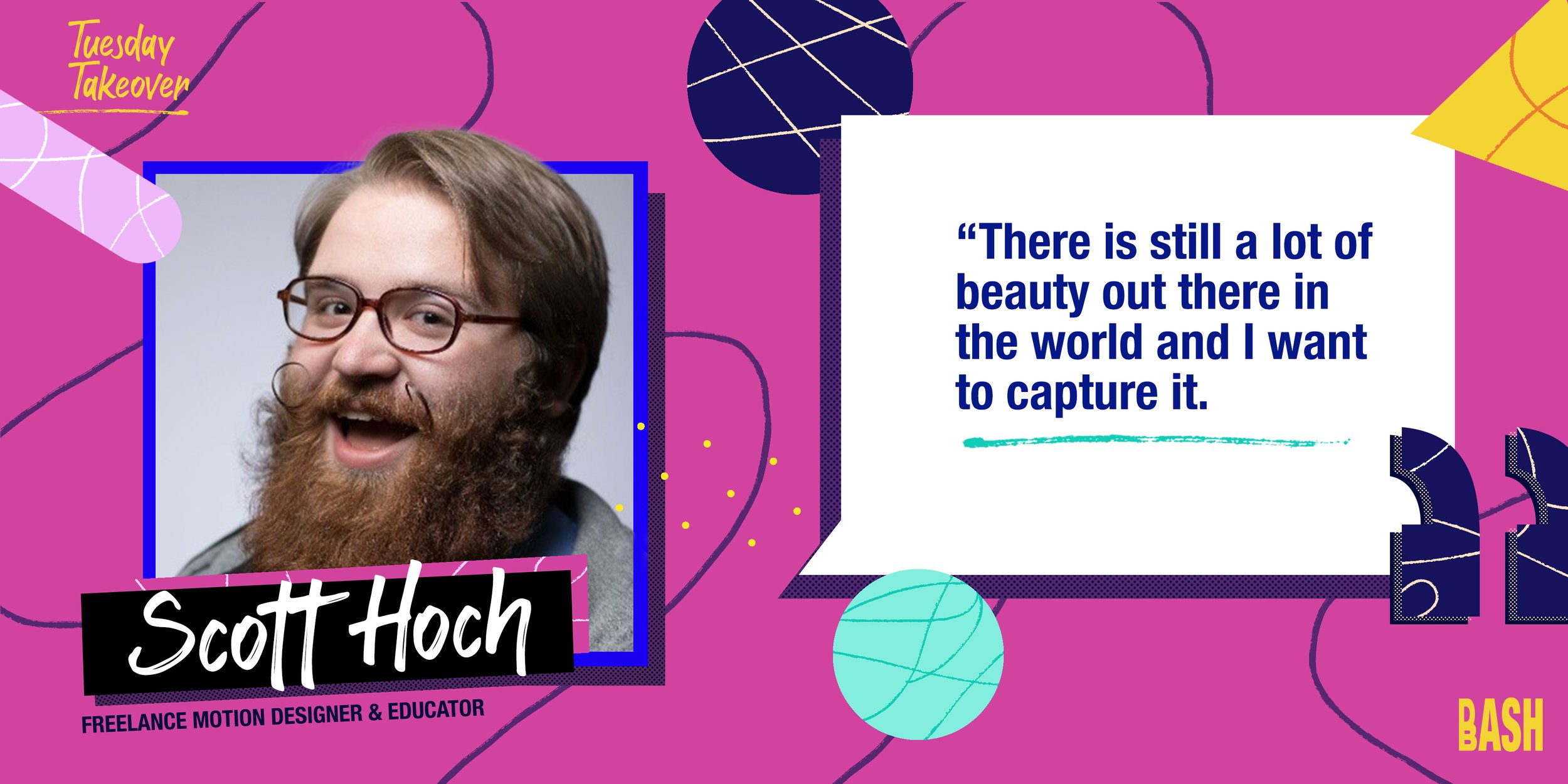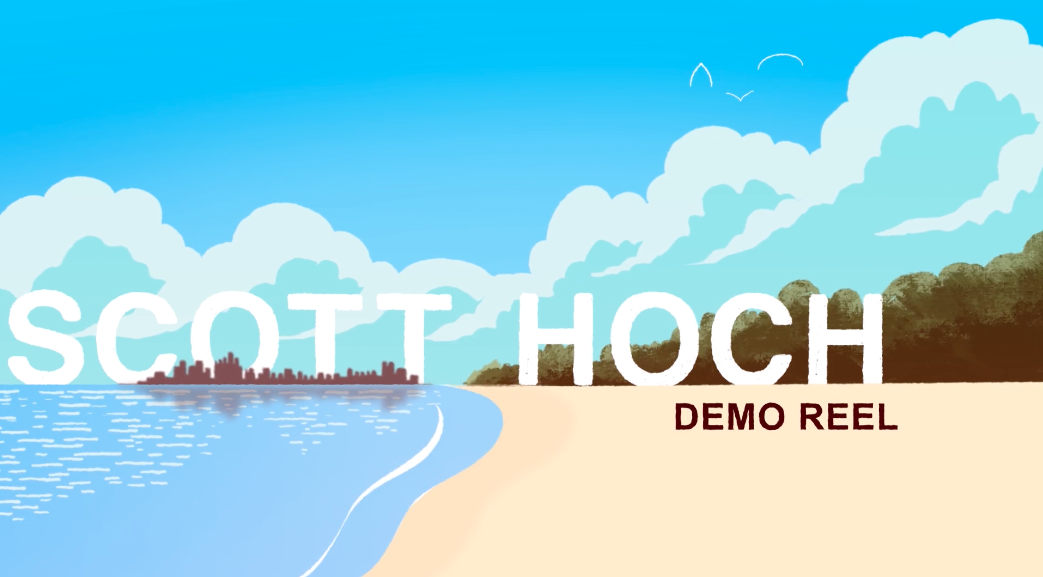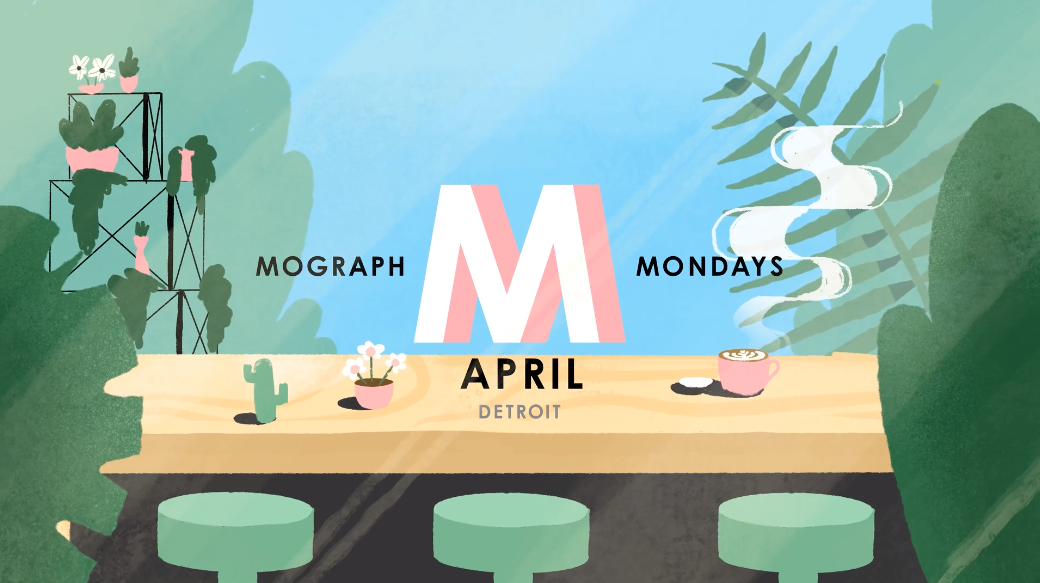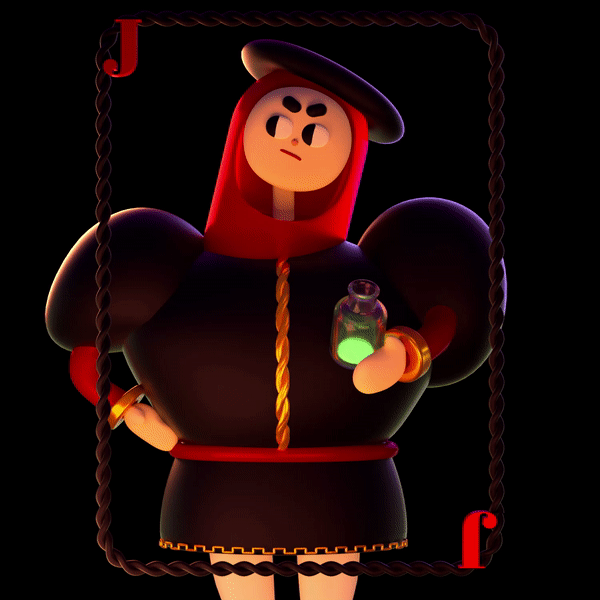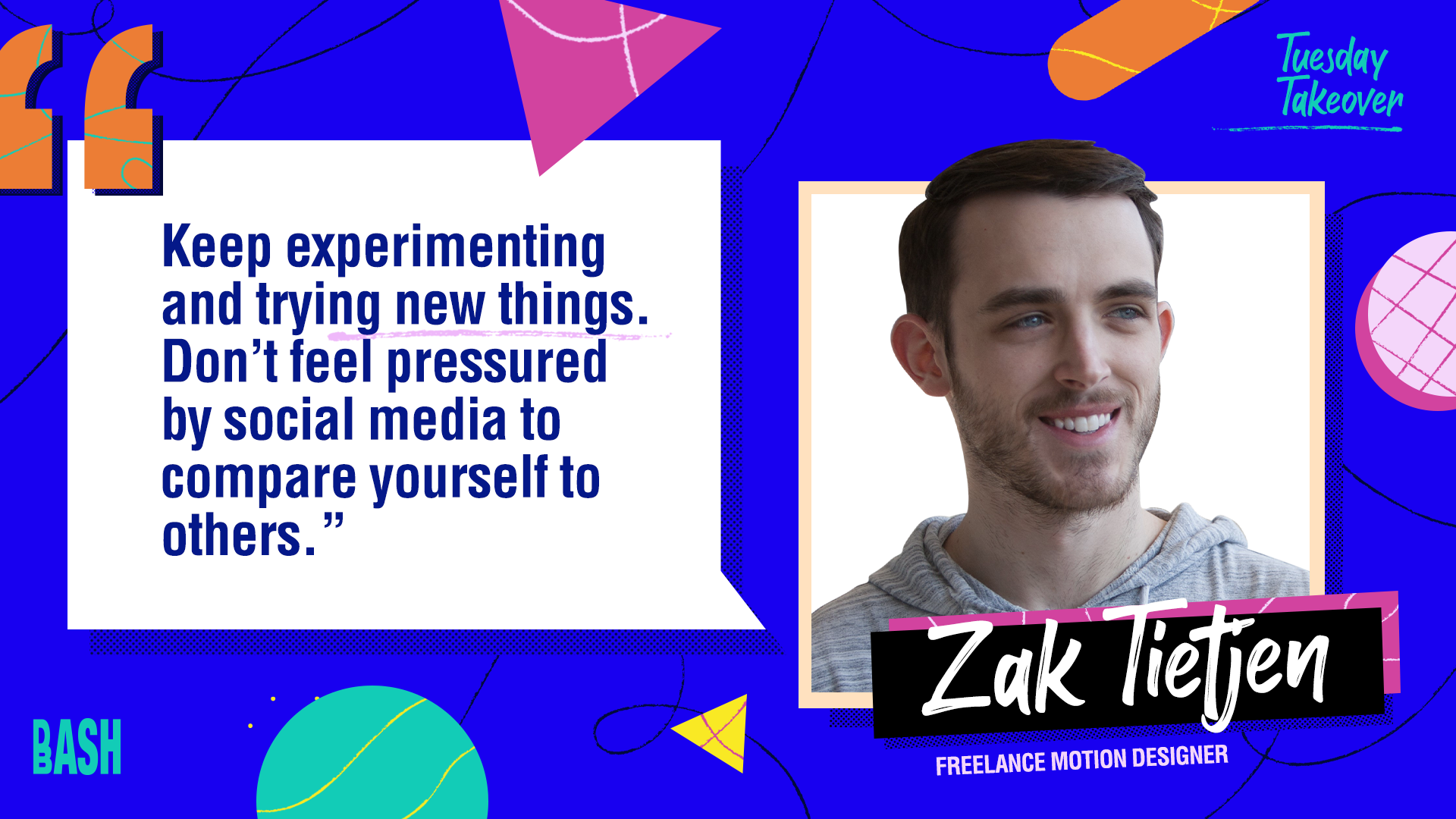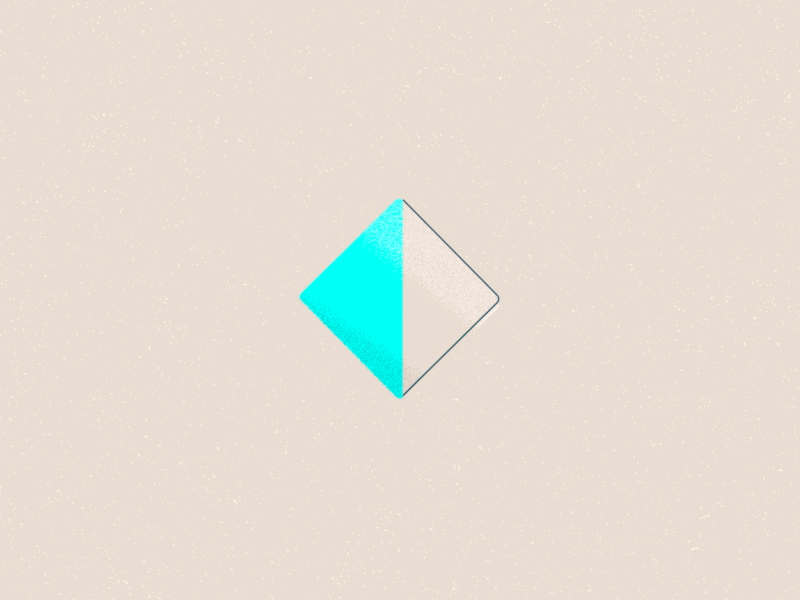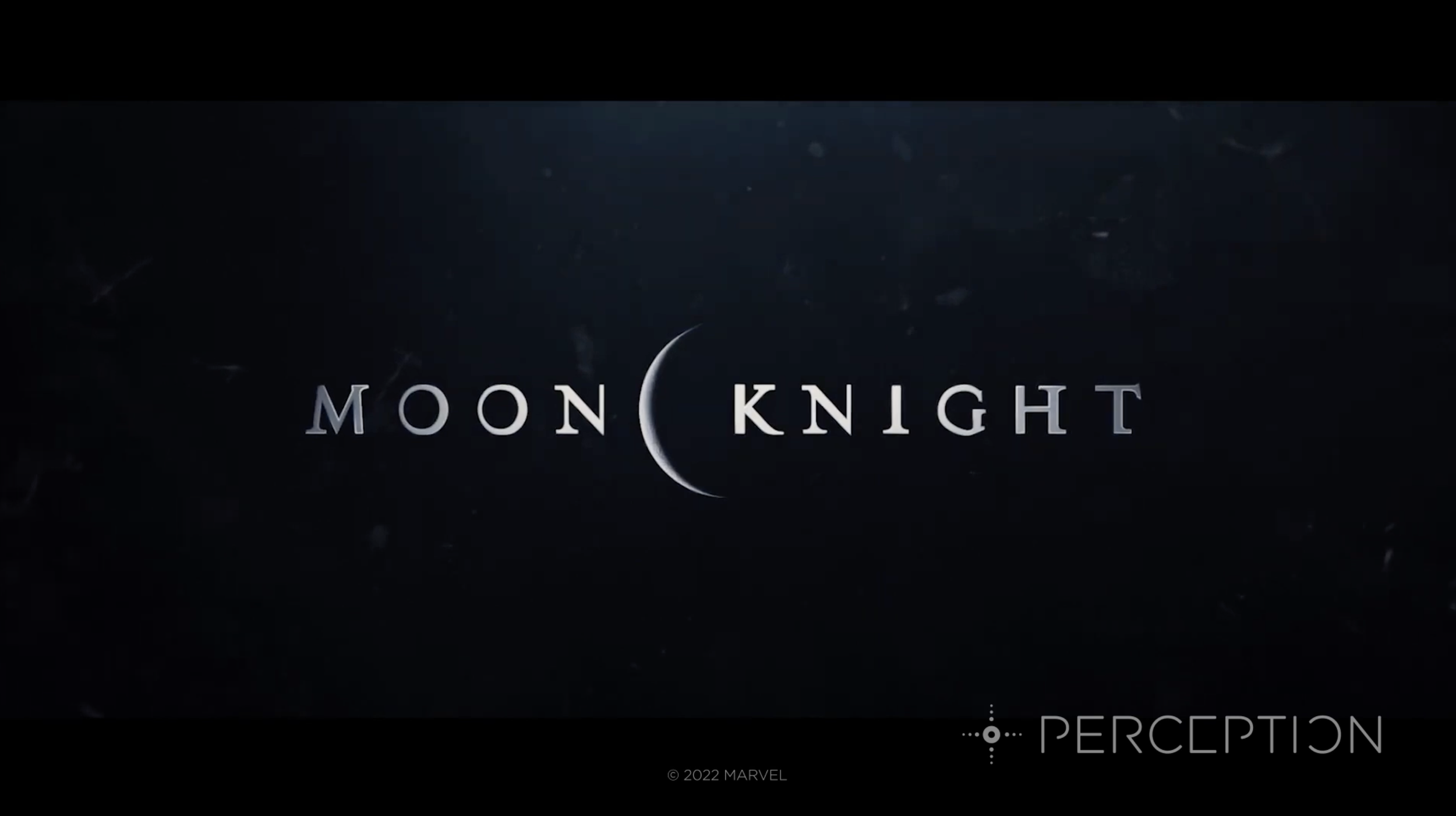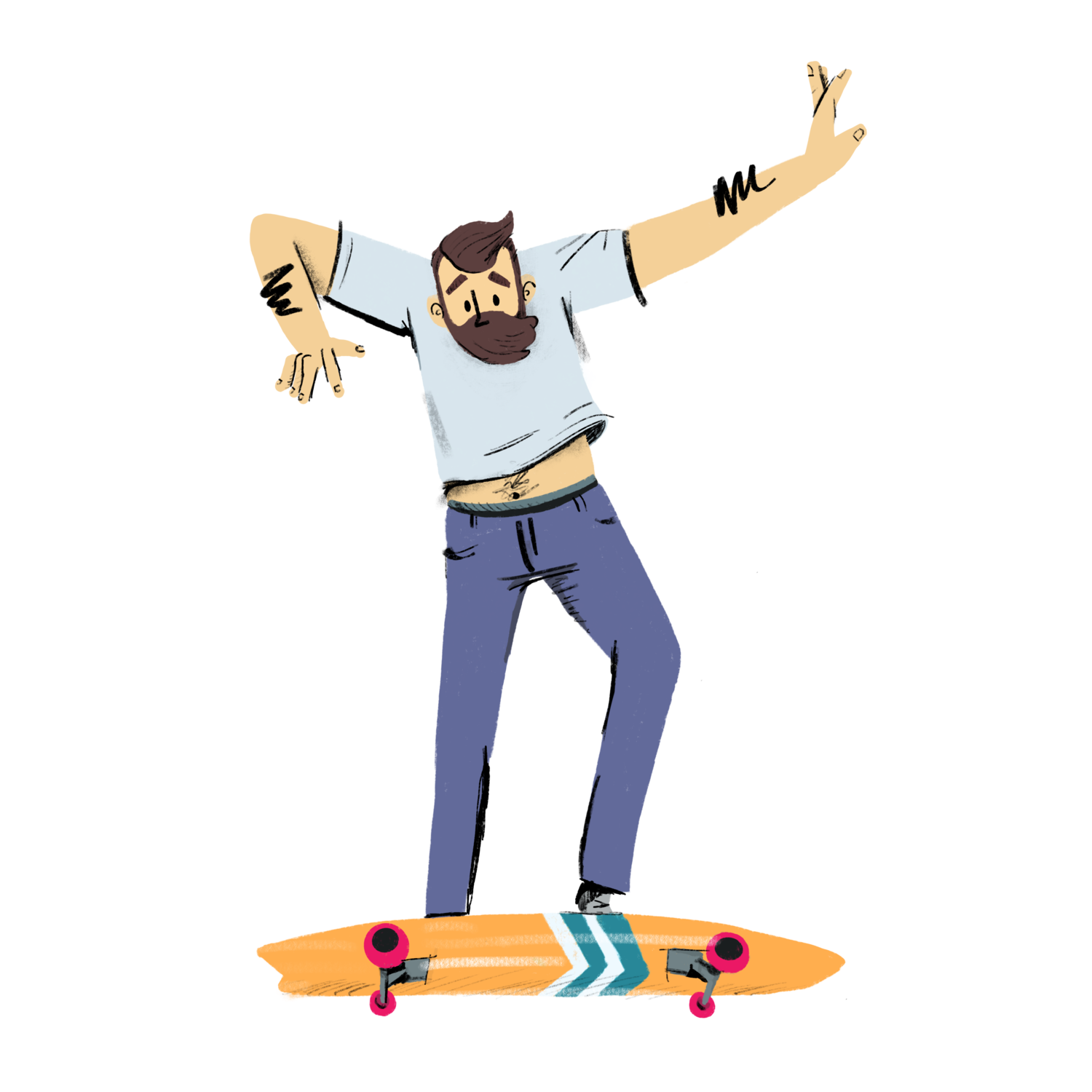Takeover Tuesday Vanessa Appleby
An interview with Vanessa Appleby: an art/animation director who straddles the divide between motion design and traditional character animation.
Q&A with Vanessa Appleby.
Read time: 5min
Bella Alfonsi:
Hi, Vanessa! Thanks so much for joining us for Takeover Tuesday. For those who are unfamiliar with you or your work, please give us a lil' intro!
Vanessa Appleby:
Hi! I'm an art/animation director who straddles the divide between motion design and traditional character animation. I've been in the business for almost 15 years now, and I've had a chance to try on lots of hats over the years.
Bella Alfonsi:
How did your career begin? Did you always know you wanted to be in this field?
Vanessa Appleby:
I did not! I've always been a bit of a renaissance woman. I have a lot of varied interests.
In high school, I started drawing caricatures at a local amusement park. I think this is probably the most influential experience of my youth. It taught me a lot about life, but most importantly, it taught me that I could make money with my art. Funnily enough, I still have friends from this time working in the NYC animation industry today.
When I entered college, I had narrowed down my career path to fashion design or animation (odd, I know), so I chose a school that had strong programs for both. I ultimately decided on animation for what I thought was a shallow reason, but turns out was actually a smart one. I liked the people who were going into the animation major much more than I liked the fashion design students. They were funny, and I love to laugh.
I started my career working as a 2d cel animator in Flash, mostly working on childrens' TV. Over the years I transitioned to AE character animation, which led to compositing, which led to commercial motion design, which led to art directing, which led to now. It's been a wild ride.
Bella Alfonsi:
On your website you explain how out of every job you’ve done, directing is by far your favorite. Why is that?
Vanessa Appleby:
The short answer? I like making a plan and executing the plan. That's easiest to do when you're the director ;)
I also love finding out what my team is passionate about and delegating those tasks appropriately. I want to foster a sense of excitement for everyone who works on my projects. It makes the outcome so much stronger.
Bella Alfonsi:
Do you have any advice for someone trying to become a director themselves?
Vanessa Appleby:
You'll have to pay your dues in the industry before people start trusting you to direct. Be patient, keep trying, and don't be afraid to take on a lower paying gig if you get to run the show. You're not going to get to start directing at one of the big studios right out of the gate. Try working directly with clients (think music videos for example) to get some directed spots under your belt. Once people see what you can do when you're in charge, opportunities will come knocking.
Bella Alfonsi:
You’ve worked with a ton of different art styles over the years. Do you have a favorite?
Vanessa Appleby:
Nope! I'm ADHD and have always loved experimenting in different mediums and styles. I like to push myself and create something unique. I do especially enjoy vector workflows, but that's not exactly a style per se.
Bella Alfonsi:
Your personal illustrations are so colorful and full of life. I think that although each piece is unique from one another, it is still evident that you created all of them. What insight would you give to someone trying to find their “style”?
Vanessa Appleby:
Ha! I may be the worst person to ask. To be honest, having a "style" has always been a point of contention I've internally wrestled with.
In our business, popular looks/styles come and go. A director who has the current "it" look may not have a long lasting career unless they are able to adapt and change with the times. I wanted to be in this business for the long haul, and being as diverse as possible was key for that. I think no matter what, your hand will always shine through even though you're trying to emulate a different look. Your hand will give you cohesion even if your brain is trying to avoid that.
Bella Alfonsi:
Where do you find inspiration when starting a project from scratch?
Vanessa Appleby:
Everywhere! I go on long walks through the city and often see funny and inspiring things. I'm also a history dork, so I tend to find inspiration from decorative arts and pattern motifs of the past. Most recently I became obsessed with Medieval illuminated manuscripts and scoured thousands of pages collecting funny marginalia creatures. Explore your passions outside of art. Inspiration can come from anywhere.
Bella Alfonsi:
As someone with 15 years of experience, what do you think the future of motion design looks like? And how is it different now from when you first started out?
Vanessa Appleby:
Motion design is already so different from how it was when I started. The biggest shift I've seen is an uptick in women in the field. Between 2008 - 2015 I was usually the only female on a team. This boggled my mind since my degree program was predominantly women.
Despite this, there were, and still are unfortunately, not many women at the top. I do think with the advent of groups like Panimation that things are beginning to change even more. I just hope it keeps going and the industry becomes even more diverse and inclusive.
Bella Alfonsi:
What is your proudest moment in your career thus far?
Vanessa Appleby:
This is a tough one- I kind of hope it's still to come!
Bella Alfonsi:
Any final takeaways?
Vanessa Appleby:
Keep going! This business can be tough, especially when you're just starting out. If what you're doing isn't getting you the results you want in your career, try a different approach. We're creative people. Don't be afraid to apply that creativity to how you grow your career or earn your money.
Takeover Tuesday with Katie Trayte
An interview with Katie Trayte: an illustrator based in Washington, D.C as well as the Creative Director at Duke & Duck.
Q&A with Sarah Chokali.
Read time: 5min
Bella Alfonsi:
Hey, Katie! Thanks so much for being a part of Takeover Tuesday. For those who are unfamiliar with you or your work, please tell us about you and what you do!
Katie Trayte:
Thank you so much for inviting me to participate! I love your Takeover Tuesday series.
My name is Katie Trayte and I’m an illustrator based in Washington, D.C as well as the Creative Director at Duke & Duck.
Bella Alfonsi:
Do you have any formal training or are you completely self taught?
Katie Trayte:
I graduated from SCAD with an Illustration degree, but I am fairly self-taught when it comes to animation. I started out of school as an apparel graphic designer for Hollister. So if I made it here, you can too! I always felt a pull towards animation and storytelling, but never really saw where I could fit into the compartmentalized pipelines of feature and tv. When I found the world of motion design I was, in a word, obsessed. I was also what the French call, "Les incompetents". My love of the work made it easy to find motivation in closing my knowledge gap. It was an area where my illustration and graphic design passions could both thrive, and I was so drawn to the experimental styles and trend-setting approaches happening in the field.
Bella Alfonsi:
You have an impressive resume of clients, like Sony, Nestle, and Discovery Channel, just to name a few! What advice do you have for freelancers first starting out who dream of working with clients like these?
Katie Trayte:
I have spent most of my career in-house. From that experience, I would say there’s a huge benefit to being part of a company or studio to get access to those partnerships. Especially if you’re still finding your style and the idea of exploring a lot of different visual directions appeals to you. In-house is also a great place to get a master class on business and sales. Confidence in these skills can help you to feel more empowered to establish and foster relationships with your dream clients as a freelancer.
Bella Alfonsi:
What steps did you take to go from illustrator/designer to Art Director? Do you prefer doing one more than the other?
Katie Trayte:
I jumped from graphic designer in ‘the outside world’ to an AD at Demo Duck. Not having much motion design experience behind me at that moment was… different, but a lot of the skills that had led me to advance in design roles were still very applicable despite the shift between industries. Effective communication, articulation of ideas, and management skills all help take you from making great art to leading great art. I have such a strategy brain that I’d say art director is the role for me. I love being client-facing and problem-solving along the way during a project. I still get to do a fair amount of hands-on work in an AD role, so it’s a win-win!
Bella Alfonsi:
Do you have any advice for someone trying to become a director themselves?
Katie Trayte:
Start by demanding excellence from yourself in your area of production. If you’re producing high-quality work in your role, you’ll be trusted to own more and more of the pipeline. Hone your voice, always concept from a unique angle, and keep learning about areas of production that may be outside your expertise. Most importantly- develop your people skills! Effective negotiation, collaboration, and communication help to win the respect of your client and your team. At the director level, more often than not, your people skills are going to be what makes or breaks the success of a project.
Bella Alfonsi:
Tell us a bit about the piece, Be Aware. What was it like working with Barbra Streisand? How did the unique painterly approach come to be?
Katie Trayte:
Be Aware was such a dream to work on. Barbra Streisand was much more involved in the review and development of the project than I was expecting, which was a really fun surprise. I even have a first pass of my storyboards that came back to us with her handwritten notes on them! Treasure. She and Sony were both great clients.
Since moving to DC I’ve become friends with Elyse Kelly, who is an independent director and founder of Neon Zoo. I admire her work so much, and when she asked me to join the project I was excited about the opportunity to shadow her directorial expertise. The painterly approach came out of a lot of style development with Elyse. We wanted a look that matched the song- sweeping, emotive, and sensitive to the subject matter. I did initial sketch boards in a gestural, loose hand and that treatment felt like a natural marriage to the song lyrics. Elyse’s body of work is very painterly, so her talented animation team was very equipped to bring the look to life.
I love to paint, but most of my work up to Be Aware has had to be very graphic-driven. It felt like I got to really be myself with this style and say, “Don’t bring around a cloud to rain on my parade!”
Bella Alfonsi:
When you find yourself in a creative rut, how do you get out of it?
Katie Trayte:
Working remotely, (like I do now), or working freelance can make a creative rut feel like a creative canyon. An impossible abyss of creative failure from which you will never escape! On my own, I have never had a great solution for these difficult patches other than to take it easy on myself and let time pass, knowing that I’ll move beyond it. As a team, we’ve started a lot of open dialogue about overcoming ruts and are committing to more open avenues of collaboration this year. We’re working to let go of any self-inflicted shame associated with being stuck by reaching out to each other to talk through blocks, hurdles, or low points before they get too far. We’re having a lot of success. Working remotely, you're much more prone to anxiety and self-doubt that can make you retreat inwards. We’re all being intentional about training ourselves out of this habit through communication and feeling safe to be vulnerable with each other.
Bella Alfonsi:
What or who inspires you?
Katie Trayte:
Both in my personal time and inside Duke & Duck we’re making more of a commitment to developing children’s IP. We’re even starting a sister brand for kid’s content called Double Scoop Studio! About a year ago, we discovered how much talent there was on our team for telling character-driven episodic content and have wanted to give that talent an outlet. That’s been a big inspiration to me- having this group of people come together that are committed to starting this new ambitious journey. I love working with my team to help find the special stories we have within us. Working together to grow these ideas, with a lot of laughter and joy along the way, feels like magic.
Currently, I’m really inspired by any kids media that takes more of a motion design direction to its animation approach or offers a new style in the space. Hey Duggee, Wide Load Vacay, City Island, StoryBots, and City of Ghosts are all great examples.
Bella Alfonsi:
Any final takeaways?
Katie Trayte:
I think I’ve said it all. Thank you so much, Dash team, for hosting these interviews and for always finding great ways to bring our community together!
Takeover Tuesday with Sarah Chokali
An interview with Sarah Chokali: a passionate and multidisciplined motion designer based in Brooklyn, New York. I was born and raised in Baghdad, Iraq, and have had a lifelong interest in the power of visual storytelling.
Q&A with Sarah Chokali.
Read time: 5min
Mack Garrison:
Thanks for participating in our Tuesday Takeover series, Sarah. For folks not familiar with you or your work, could you give us an introduction and a little background on how you got into the creative space?
Sarah Chokali:
Thank you for having me in the Tuesday Takeovers alongside inspirational artists I’ve admired.
I'm Sarah Chokali, a passionate and multidisciplined motion designer based in Brooklyn, New York. I was born and raised in Baghdad, Iraq, and have had a lifelong interest in the power of visual storytelling.
Growing up in a challenging environment sparked my creativity and my love for art at a young age. I've always been fascinated by the way that visual expression can create a connection between people.
I’ve started my career as a graphic designer around 2014. However, my passion for animation led me to discover the world of motion design. Since then, I've been on an ongoing journey to learn more about using motion to communicate and bring ideas to life. I aim to create impactful visual experiences, and I’m not tied to one design discipline. I am working on experimenting with different techniques.
Currently, I’m working with the dream team at Grandarmy at their office in New York City.
Mack Garrison:
You've got an entertaining portfolio in a variety of styles! Do you have a preferred medium you like more than others?
Sarah Chokali:
That's a great question. I'm a bit of a medium maverick. I don't believe in playing by the rules and sticking to just one medium. To me, the magic happens when different mediums come together to create something truly unique and unexpected as long as there is a clear contrast, whether in values, shapes, textures, and/or colors.
Having said that, After Effects is like my home base, the central hub where all my creative ideas come together. It's where I can bring all these different assets and techniques together.
Mack Garrison:
Some would say that 3d motion design work and illustration work are on opposite sides of the creative spectrum. How does one approach influence the other?
Sarah Chokali:
It's true, 3D motion design and illustration can appear to be on opposite sides of the creative spectrum. But for me, it's less about the differences between the two and more about the different processes that go into each.
I think of it like this - sometimes, I sketch an illustration on my iPad using my pen on the screen, then I'll bring those sketches into Adobe Illustrator and use the pen tool with my mouse to refine the lines. Both steps are part of creating an illustration, but they require different approaches.
The same goes for 3D motion design. During the process of building abstract shapes and bringing them to life in 3D whether using simulations of keyframes, it can be very different from the traditional illustration process. Both methods bring me joy and excitement; by combining different techniques in one place, a new style can be born.
The switch between different mediums is challenging. It didn’t come easily to me, especially when I’m fighting that resistance to using my comfort tools instead experimenting with new techniques. It takes time, practice, and dedication to combine different techniques. I had to sacrifice a lot of my social life and even some sleep in order to learn 3D, but my drive to create unique visuals kept me motivated.
I don’t recommend the combination unless you have enough energy and time. Nothing is more important than our health.
Mack Garrison:
Great answer! I really love your character work; both illustrative and the 3d versions. Where does the inspiration for each come from?
Sarah Chokali:
It’s flattering to know that you find it this way; thanks a lot.
My inspiration for the characters comes from my desire to challenge gender norms and celebrate femininity. Growing up in an environment where being a woman was seen as a sin and with limited representation, I've always been drawn to creating strong female characters. I find joy in bringing these characters to life, both through my traditional illustrations and through my 3D animations. I consciously and subconsciously find it as a way to give a voice to those who may have felt suppressed in the past and to provide a positive representation of women in my work.
Mack Garrison:
What’s an ideal project for you, and is there a brand you would love to work with?
Sarah Chokali:
Since I’m currently not a freelancer, I’d say what makes a great project to me is the project where I need to push out my limits and seek to create unique visuals for it.
Mack Garrison:
It's always hard to choose a "favorite" project, but is there one piece that really sticks out to you?
Sarah Chokali:
Ah, that’s so tough, especially given that the most interesting projects are still in production. But I just started a new passion project where I share a breathing exercise for the social media scroller. This project is dedicated to creating animated content that offers a peaceful refuge for the mind. Also, it is gonna be an exercise for me as a motion creator.
Mack Garrison:
Can’t wait to see it! I know you're a big advocate for women in tech. What are some initiatives you're currently working on?
Sarah Chokali:
It has always been a pleasure and great responsibility to advocate time and efforts to help unrepresented groups. I’m involved with Code Lab initiative in Baghdad, which focuses on creating the first AI hub in Iraq by organizing bootcamps and workshops. However, I’m temporarily not as active as I used to be when I was present in Baghdad. My goal is to create impactful content that serves to inspire or represent oppressed voices, especially women in my country.
Mack Garrison:
How has growing up in Iraq shaped your professional career?
Sarah Chokali:
With every challenge comes a new opportunity to learn and develop. Living in Iraq was like living life in a difficult mode. Not only I experienced economic sanctions, two wars, and a civil war that cost me to lose friends and family members. But I also experienced living in a society where women are titled to be only good wives and caring mothers. While I was lucky to have supportive parents, the environment was unfair to women. Women’s freedom and independence are far away from being a reality.
I was vocal about my rights as a human being to work and choose my path. My desire to make an impact and work passionately as a creator was unrealistic to dream of in the environment I lived in.
But I was curious about animation creation. When my uncle’s house got a computer, I stayed there playing with MS paint and was fascinated by that software. Yup! I imagined I could create things frame by frame with that software.
It’s more like my motion design career helped me get independence. Additionally, when I paid for my work, I’d save 75% of it to invest in optimizing my work process to overcome the challenges I was facing.
My background has shaped me into a more determined and resilient individual, always seeking to learn and grow in my craft.
Mack Garrison:
Any final takeaways for our audience?
Sarah Chokali:
Thank you for taking the time to learn more about my story with motion design.
With motion design being a rapidly expanding field, it's truly an exciting time to be a part of this industry. Accessibility to resources has never been easier, and if creativity gives purpose to your life, then listening to your intuition, overcoming obstacles, and putting in hard work can lead to fulfilling that purpose.
However, keeping up with the constant advancements in technology and technique can be intimidating, which is why it's crucial to prioritize rest. This includes taking breaks from social media and focusing on physical and mental health. Social media platforms are designed to consume as much of our attention as possible, making it even more important to reduce the time spent scrolling and redirect that energy toward what truly matters. It sounds easy but we all know that many of us find it challenging to limit the impact of social media on our energy.
Takeover Tuesday Scott Hoch
An interview with Scott Hoch: a freelance motion designer from Detroit, Michigan.
Q&A with Scott Hoch.
Read time: 5min
Matea Losenegger:
Hi Scott! Can you introduce yourself and explain what you do?
Scott Hoch:
Howdy! Thanks for having me, I’m stoked to be here. My name is Scott, I’m a freelance motion designer from Detroit, Michigan. I also teach digital animation part time at my alma mater, College for Creative Studies (CCS). I like birds, movies, coffee, and making pixels move on screens. Lately I’ve been really thinking about my identity as an artist and where I want to go from here. It’s the beginning of the year so it’s a time of self reflection. I'd say you reaching out to me was good timing because I wanna talk about it!
Matea Losenegger:
What sparked your interest in design and animation?
Scott Hoch:
As long as I can remember I’ve loved drawing and making people smile. I drew all through elementary school, designed t-shirts for my friends' screamo bands in high school, and after that I got an animation degree from CCS. My ambitions were never really focused, I only knew I wanted to do creative work, make a decent living, and make others happy. At one point in college I MAYBE thought I could move to LA, work in TV or feature animation as an artist. Maybe even direct movies. It turns out LA is super competitive and the housing market is a complete joke. If I didn't get a job after graduation I'd be completely screwed but I did not want to move across the country away from my family to MAYBE get a job that hardly covers rent not to mention my debt. I needed to find a different path.
It was around this time that I was introduced to both After Effects and the Detroit Mograph community. Not only was I hooked on this program that could seemingly make magic happen at the push of a button; there was a whole industry outside my front door welcoming me with open arms. There really is something special about a bunch of Midwestern nerds all into the same nerdy shit as you. I instantly felt like I belonged. Soon after I graduated I got an internship as a motion designer for a mortgage company where I learned the ins and outs of the studio system. Two years later, Julie Craft convinced me (and the rest of Boxfort basically) to quit my job and go freelance.
I'm so happy that I didn't have to move away from home to be an animator. Detroit has such a unique identity that is a part of me; I don't know if I’d fit in anywhere else. It’s the perfect sized city, not too big, not too small and there’s lots of nature in the area too! There are so many more artists and creative folks here than anyone would guess because that part isn’t talked about nearly as much in the news. Heck, I didn’t even know it until I was in college. I love Detroit, I could go all day but I’ll leave it at that. Come visit!
Matea Losenegger:
What’s it like being a part of an animation collective like Boxfort and how often do you all get to collaborate?
Scott Hoch:
It’s the BEST! At its core Boxfort is just a coworking space that a group of friends share so we don’t go crazy working from home all the time. Though, to be honest, I only go in a few times a week. One of my goals this year is to go more often regardless of if I’m booked or not. It’s a wonderful space with cool vibes, hacky sack, movie nights and, yes, there is LaCroix in the fridge. As far as collaboration we all work on such different projects it’s not common that we collaborate on client projects. Sometimes 2 or 3 of us can work together on a larger project but we’ve never truly staffed up to work on a big campaign like a studio would. I think we all prefer being independent. I also think we prefer putting our collaborative potential into short films and music videos. Deep down we’re all storytellers and we love working together to make our ideas a reality. I know all of us at Boxfort are itching to produce more shorts this year so stay tuned!
Matea Losenegger:
You have a slick, succinct reel with a strong intro and outro. What was the thought process behind it and what would you say makes a compelling reel overall?
Scott Hoch:
Maybe an obvious answer but thanks to the internet age everyone’s attention span has been completely obliterated. People can process information really really fast these days which means they can also get bored really fast. I read somewhere that art directors will know within 15 seconds of a reel if they’re going to hire someone. I have no idea if that’s true but why risk it? The intro and outro is one of my happy places. I think everyone should keep a list of their most favorite places and memories. Whenever I have trouble drawing something I just think of clouds, trees, water, sand, lots of stuff! A lot of my art is very intuitive, my hand takes me where my heart wants to go. I love the beach, I love the way it makes me feel. When people watch my reel I want them to be sucked in by the cool ocean breeze and calm waves right before I bombard them with crazy visuals. Then as soon as the reel is really getting you amped up it’s over and we’re looking at a nice pretty wave again. You gotta ease in and ease out amirite?
Matea Losenegger:
I really love the use of color across your portfolio. What is your strategy in creating a successful palette?
Scott Hoch:
There are tons of sites that will show color palettes from different movies or from nature that you can use and I think over time I’ve gotten a better sense for making my own. Coolors.co is a really great site to generate quick palettes that work well together. I'm also fortunate to work with a lot of incredible illustrators that are much better with color than I am. Perhaps from animating their designs I've gotten better at color from osmosis. Honestly I never thought of myself as having good colors so I really appreciate you saying that!
Matea Losenegger:
Is there a particular type of project you like to work on?
Scott Hoch:
Any project where I can collaborate with kind talented people are the ones I like best. Seeing others bring their A game inspires me to do my best. It also helps when my values align with the mission of the company I’m working for. Beggars can’t be choosers in the freelance world but I definitely feel better when I believe the work I’m doing is helping people. I’ve been fortunate to provide animation services to some non profits in the area and would love to do more “good” work with the skills I have.
Matea Losenegger:
Who would be your dream client or artist to collaborate with?
Scott Hoch:
As an avid birder I would do anything to work with the National Audubon Society. Conservation is a very important cause to me and I would be over the moon if any of my work someday helps with wildlife conservation efforts. Lower down the list but still big dream clients for me would be any climate change organizations, any local Detroit businesses or even small coffee brands. So if any Detroit coffee shops that do charity work for birds by tackling climate change are reading this, I’m your guy.
Matea Losenegger:
As a seasoned freelancer, what are some of the challenges and benefits that come along with the lifestyle?
Scott Hoch:
I'm sure you've heard this a thousand times but the biggest benefit of freelance can also be its biggest challenge. You are your own boss. It's up to you to keep yourself busy working on your business both on the clock and off. Your schedule is more flexible but you're constantly thinking about your next gig, your taxes, networking, healthcare, retirement, death, taxes, marketing yourself, editing that reel you'll never finish, social media, taxes, etc etc etc. It's a good gig if you've up for the challenge but it's not for everyone. I love being freelance but I'm not sure what the end game is and can see myself going staff one day if the stars align.
Matea Losenegger:
Do you have any advice for aspiring creatives or freelancers out there?
Scott Hoch:
I think art can be an addiction much like any passion. When you're young you're filled with so much anxious energy to create as much work as possible to improve and hopefully get a job. It's good to light a fire under you for a while. But someday that light is going to burn you and if you're not careful it could completely engulf you. Take breaks. Go on trips. Spend time with your loved ones. Art isn't worth sacrificing your health for. I tell my students this all the time but the immense pressure they’re put under, the greatness we expect from them, it’s no wonder why so many artists are nervous wrecks.
In this modern world we live in, everything has been commoditized and our eyeballs are currency. Companies are competing to get the most eyeballs to watch their thing for 6 to 30 seconds before they click or swipe away. I keep saying I’m an artist, that we are artists but that isn’t true. We are content creators. Just throwin’ more chum into the garbage disposal that is the internet. I’ve spent so much of my time in recent years fixing my relationship with art. How does one create something worth anything in a world that’s on fire? What’s the point? And don’t even get me STARTED on AI art.
Clearly I have a ways to go but I feel hopeful for the future somehow. Maybe the point is to defiantly do what makes you happy against all odds. There is still a lot of beauty out there in the world and I want to capture it. Life moves pretty fast. If you don’t stop and look around once in a while, you could miss it. I came up with that quote, don't look it up.
Matea Losenegger:
What does 2023 look like for you? Are there any projects you’re excited about?
Scott Hoch:
My schedule is actually wide open right now as far as client work is concerned (cough cough hit me up). I think 2023 is going to be a big year of growth for me. The last few years I’ve felt a bit stagnant with my personal art (see above, re: world on fire) but I’ve been taking some online courses and drawing in my sketchbook more lately. Turns out art IS still fun! I really want to add more storytelling to my work like a concept artist would. I want to play with lighting and color and value. Heck, maybe I’ll take up gouache. I feel like I’m finally ready to open the door to growth and the world feels wide open to me again. We’re always told to stay curious and enjoy ourselves but it’s easier said than done. Thank you again so much for reaching out to me and giving me the opportunity to chat! I hope everyone has a great 2023!
Matea Losenegger:
This was great! Thanks, Scott.
Takeover Tuesday Abbie Bacilla
An interview with Abbie Bacilla: 2D and 3D motion designer and illustrator.
Q&A with Abbie Bacilla.
Read time: 5min
Matea Losenegger:
Thank you for taking part in our Tuesday Takeover series! Can you give us a little insight into you and your work?
Abbie Bacilla:
Thank Y’ALL for considering me for Tuesday Takeover! My name is Abbie Bacilla, I’m a 2D and 3D motion designer and illustrator. I work primarily in tech, but love to do character animation on the side.
Matea Losenegger:
What made you pursue design and animation as a career?
Abbie Bacilla:
Animation was always something I wanted to pursue; I wanted to work for Cartoon Network or Disney when I was in high school, but CalArts was (and is) way too expensive. Instead, I went to a small liberal arts college and shifted to graphic design, because I thought it would lead to more jobs. While in college, I happened upon a night class for motion design. My professor gave me the impression that it was way easier and faster than frame-by-frame animation, so I gave it a shot. I ended up liking it so much, I shifted my whole career to it!
Matea Losenegger:
What is it like to work at Frame.io on a platform that’s growing so fast within our industry?
Abbie Bacilla:
It’s incredibly exciting to work for a product that other motion designers use. It’s the reason I wanted to work for Frame.io in the first place – it’s a great product with great people working on it! I’ve been at Frame for almost five years, and I’ve had the privilege to watch the company grow from under 100 to over 500. It’s a unique situation for sure, and made me learn a lot of motion techniques and soft skills very quickly. I highly recommend working in a small in-house team at least once; it’s very rewarding to build a brand and make content with a tight-knit group of creatives.
Matea Losenegger:
How would you describe your art style and what was the path that brought you to it?
Abbie Bacilla:
I like to keep my Frame.io and personal art styles separate. My Frame.io “art style” is more about the motion; we like to look at the minimalist typography trends that other tech and film brands are achieving and apply it to our own brand voice. My personal art style stays in the realm of round, colorful and expressive characters, mainly in 2D but sometimes in 3D. I love stretching and exaggerating emotions with a character’s face and body language.
Matea Losenegger:
The characters you create are so fun and playful. What is your process for bringing them to life?
Abbie Bacilla:
In the beginning, LOTS of pinterest boards and instagram bookmarks. I try to actively seek inspiration rather than wait for it to jump in my lap. I’m mainly inspired by runway fashion, drag, video games, cartoons, and my own life experiences. When I’m sketching, it’s really important for me to streamline the character’s shape language and cut unnecessary detail. In the future I’d like to experiment with more geometric, sharp character designs, rather than my usual bubbly style.
Matea Losenegger:
Do any of your projects stand out as a favorite?
Abbie Bacilla:
My short film that I launched in October, Spacepup, is my favorite so far! It was originally created for the anthology series Things Took a Turn, but I’ve submitted it to a multitude of festivals in New York. I’m hoping it’ll get selected for at least one, so I’ll be able to watch it on a big screen with my best friends in 2023.
Matea Losenegger:
What was one of your most challenging assignments?
Abbie Bacilla:
The first fully-3D launch video I made, Frame.io’s iPad app in 2019. I had a very rudimentary knowledge of Cinema4D at the time, and was limited to Arnold as a third party renderer since I only had an iMac Pro to work with. I was put in charge of the story and boards, so I had to partially direct all the live action bits. I learned a lot from creating that video, and it gave me a taste of what a director role would look like!
Matea Losenegger:
I see you’re a four-time School of Motion alumni and have a wide skill set in 2D and 3D. Are there any areas in animation that you haven’t explored yet or would like to?
Abbie Bacilla:
There are too many things to learn! I know every motion designer is saying this, but I’m going to try and dive deeper into Blender. I follow a lot of Blender artists on Twitter and they’ve inspired me greatly. Other than that, I’m at a point in my career where I need to double down and expand/improve what I can do with Cinema4D and After Effects. Cinema4D is just a rabbit hole of possibilities. I just need the right project to inspire me to learn more!
Matea Losenegger:
On your site you mention that some of your hobbies include video games and drag shows. Have you found any inspiration from those things for your work?
Abbie Bacilla:
Yes, absolutely! There are so many creative AAA and indie games that inspire me all the time – my latest favorites have been Pokemon Scarlet/Violet, Hades, and Cult of the Lamb. I’d love to create 2D character animations and assets for an indie game someday, ideally for a side-scroller like Cuphead or a fighting game like Skullgirls.
As for drag, it’s not the most obvious source of inspiration for motion design, but that’s why I love it! Drag is great inspiration in terms of color palettes, shape language, visual storytelling, comedic timing and motion in general. I’m a queer artist living in NYC, so I have an abundance of local drag I can go see. But I also watch shows like Rupaul’s Drag Race and Dragula – they’ve really popularized the art form and made it more accessible. Highly recommend both shows as well as supporting the local drag in your area!
Matea Losenegger:
What does 2023 look like for you? Are there any projects or upcoming endeavors you’re excited about?
Abbie Bacilla:
I’m collaborating with a friend on a character-heavy short, which I’m very excited for. Other than that, I haven’t consistently kept up with my drawing since covid started. I think 2023 will be the year I develop my visual style and start posting illustrations and 3D renders more.
Matea Losenegger:
What advice would you give to aspiring creatives?
Abbie Bacilla:
This is a common one, but I would find a hobby or source of joy outside of motion that can inspire your work. For example, my latest short film was inspired by my dog Ernie. Not that I’m saying to get a dog – it’s a big responsibility and it’s not for everyone – but it could be pottery, a sport, a tabletop game, book club, anything that will get you outside your home and office and talking to people!
Matea Losenegger:
Thanks so much, Abbie! This was a great chat.
Takeover Tuesday Zak Tietjen
An interview with Zak Tietjen: an animator & illustrator/designer living out in Columbus, Ohio.
Q&A with Zak Tietjen.
Read time: 5min
Mack Garrison:
Zak! I've been lucky enough to work with you over the years, but for those that don't know who you are, tell us a bit about yourself.
Zak Tietjen:
Thanks so much for having me! I’ve really enjoyed reading other interviews of people I’ve admired & some friends of mine.
I’m an animator & illustrator/designer living out in Columbus, Ohio. I love working on a variety of projects from 2D shape animation to cel animated characters and all the way to realistic 3D animation. I have a wife, 2 little girls and 2 dogs who I love spending my free time with at playgrounds, hiking, or cooking up some new recipes.
.
Mack Garrison:
As more and more folks choose to live and work in smaller markets, tell us a bit about how you were able to build a successful freelance career in Ohio.
Zak Tietjen:
Honestly, I feel like I sort of stumbled into it. I’ve been freelancing for about 6 or so years now and thankfully I’ve been able to build up a lot of connections outside of Ohio. It started slow but it was very important to me to build up trust with any studios/agencies/clients that I worked with. Never miss a deadline, always communicate when you need more time or don’t know a certain skill/technique (but willing to learn), and try to meet or exceed expectations for the project. And honestly, just don’t be a jerk haha. These are all things that several people before me have said, but following those loose guidelines is what I think allowed me to thrive working remotely, before the pandemic made it more common. After doing that enough, you start to get good word-of-mouth. Friends would recommend me for projects or studios would come back because they know I’ll make it easier for them by working hard and hitting deadlines.
Mack Garrison:
Let's jump into style. How would you describe your aesthetic and your work?
Zak Tietjen:
Oof, that’s a tough one. I’ve been told that I have a certain style but I guess I don’t really see it that way. Admittedly, I love dabbling in a bunch of different styles but I think what people see as a through line is how I animate. I love bringing some of my humor into my character work, when possible. My wife won’t admit I’m funny, so I like to use my work as an outlet. I also really love a nice blend of styles, since that reflects a bit of my skillset. When there’s a lovely blend of 3D & 2D (heck, throw collage in there too!), that’s what excites me! I get bored staying within the same style and I like to jump around. It might also be a bit of envy (or overconfidence haha) when I see artists I admire creating amazing work in other styles and I think to myself “Oh! I want to try that!”.
Mack Garrison:
What are some of your favorite types of projects to work on? Do you have a favorite project from over the years?
Zak Tietjen:
What I love about this industry is that there is such a massive variety of mediums that we can work in. I could be working on some fun cel animation and brush up on my drawing skills, or finding new ways to keyframe some bouncy shapes in After Effects. Then I’ll get tactile and step away from the computer to explore some collage style animation, or rig up some goofy 2D characters. And there are so many opportunities that excite me. The majority of my work is what I’d consider ads, but I’ve also done title sequences, billboards in Times Square, UI animation for tech conferences and graphics for large sports stadiums. Because I’m able to hop around a lot, I think that helps keep each project interesting.
A couple times a year I’m asked to give a talk to the seniors at my alma mater Bowling Green State University and I always try to explain to them that working in this industry doesn’t have to feel like you’re doing “soul-sucking ad work”. I try to find opportunities in every project to do something I consider fun. Whether that’s taking a 2D illustration and giving it a bit of faux 3D in After Effects or pushing the creative a little bit beyond what’s expected. This also brings it back to building that trust and trying to exceed expectations, when possible. Each project presents its own challenges, and at my core, I’m a problem-solver. It’s fun for me to break down a challenging shot and see how we can break it down into smaller actions.
Mack Garrison:
Who are some artists and studios that really inspired you?
Zak Tietjen:
That’s always a tough question to keep concise haha. I find inspiration from so many things and artists, but I’ll try to avoid the usual freelancers & studios that everyone is familiar with. Nocky Dinh is an amazing artist who I had the pleasure of working on Hawkeye with and I was blown away by her talent. She can seemingly crush both 2D & 3D styles. Continuing the trend of title design, Arisu Kashiwagi was another amazing artist who I found on Instagram and I was surprised how much of her work I already had seen & loved. And then Petrick is a collective I believe in Germany, but they’re chock-full of absolutely stellar designers & animators. Everytime they release something online I’m blown away by the wonderful blend of styles and humor. And you know I’m a sucker for people who blend multiple styles together.
Mack Garrison:
What are some things folks should consider before they go freelance?
Zak Tietjen:
For a lot of people, going freelance straight out of college sounds both appealing and terrifying haha. I know it’s obvious, but you’re all on your own. You will often need to communicate directly with clients without the buffer of a studio, so you want to make sure you have good communication skills. For me, I think it helps to have worked in a studio for a few years so that you have an understanding of the full process, from producers to art directors and sound mixers. And one of the bigger tasks that often deters people from freelance is time & money management. If you have a partner or even children, those are big factors. My kids are eating machines, I need to make sure I’m planning our finances out months in advance.
It’s great to work for yourself and build your own schedule but you’re solely responsible for everything. Sometimes getting a nice check at the end of a project, it’s tempting to go get that new gadget in your amazon wishlist, but you have to plan ahead and make sure you have funds set aside for taxes as well. I could go on and on about all of the boring ‘adult things’ you should consider before freelance (I didn’t even talk about insurance or retirement!) but I’ll spare everyone haha.
Mack Garrison:
What's the hardest part of working for yourself and what's the best part?
Zak Tietjen:
I know it’s not for everyone, but I actually really enjoy working from home. I like being able to decide my own schedule. Over the years, I’ve begrudgingly forced myself to be a morning person, so I really enjoy waking up early and starting on work for a couple of hours before the kids wake up, and then spending time with them before school. This also allows me some time to go to the gym, which I think really helps fight off that feeling of sitting at a computer all day.
I’m also the chef in the house and we have a lot of mouths to feed, so if I’m ahead on my work, it’s nice that I can start prepping for dinner or run to the grocery store.
On the other hand, being solely responsible for your work & income can be a bit daunting. Thankfully, I feel like I’ve made enough friends and have a good system of keeping track of my invoices & upcoming projects that it’s rarely an issue, but occasionally there’s still that self-doubt in my mind that’s asking “What if I never get hired again?”. I’ve always been someone who tries to plan ahead for the future so having a career that’s constantly uncertain can be worrisome, but I feel like I’ve been able to figure out my own ways of staying organized and allowing some wiggle-room for uncertainty.
Mack Garrison:
For any studios or agencies reading this post, what's the number one takeaway they should know when booking a freelancer?
Zak Tietjen:
I’m not really sure I have any advice for just studios or agencies, but I do usually try to approach working relationships like friendships. We’ve all had a friend who didn’t treat you the same as you treated them. Maybe you’re the one who always paid for food or you helped them move into their new place but they can’t help you when you need it. So I try to see things from both sides.
I’ve been fortunate enough to build up some nice relationships with studios who hire me often and when they do something kind for me, I’m definitely going to remember that and return the favor. Let’s say it’s 7pm on a Friday and the client has some easy last-minute feedback (easy being a keyword haha). If I’m at home, I don’t mind quickly changing that for the studio because one day my kids will be home sick from school and I’ll have a slow day or maybe I need to take my dog to the vet, etc.
Showing kindness or understanding in a working relationship goes a long way, and if you don’t take advantage of it (freelancers or studios & agencies), I think the output of work is likely to improve, in my experience.
Mack Garrison:
What are you most excited about with the future of Motion Design?
Zak Tietjen:
A bit of projecting here, I’m sure, but I’m super excited for all of the motion dads & moms! Relatively speaking, I’m still pretty young in this industry (the peppered gray in my hair would disagree), so I’m always wondering what kind of longevity I have as a freelance animator/designer. From my experience, typically you would hustle in a big city (L.A., New York, etc.) and either become a Creative/Art Director, or open your own studio and eventually you’d find your way to retirement.
Well, things seem to be changing now. You no longer have to live in those big cities to get work or grow as an artist and some people are just rocking it as amazing freelancers. That and now people being more open about a healthier work/life balance, and many are relocating and starting families. I’m just excited to see where that takes us as an industry. Will I still be jamming as a 60 year old freelance animator? (Can you throw my face through one of those aging filters please haha)
Mack Garrison:
Anything else you'd like to share with our readers?
Zak Tietjen:
This industry can feel so large and daunting but all takes is a simple trip out to a conference (Dash Bash Vol. 2, anyone?) to make it all feel small again. There are so many wonderful and kind people that I constantly bump into both online and at meet-ups, and I’m incredibly grateful for all of the friends I’ve made. There’s nothing better than seeing another friend pop-up on a kick-off call, on the 1st day of a long booking.
By nature I’m an introverted person, but I extremely value the friends and connections I’ve made along the way. So if you haven’t tried to put yourself out there and go to some in-person meetups, I highly recommend it!
Mack Garrison:
Thanks so much, Zak! This was a great chat and I know a lot of folks will be happy to have your insight. And see you at the Bash this July!












